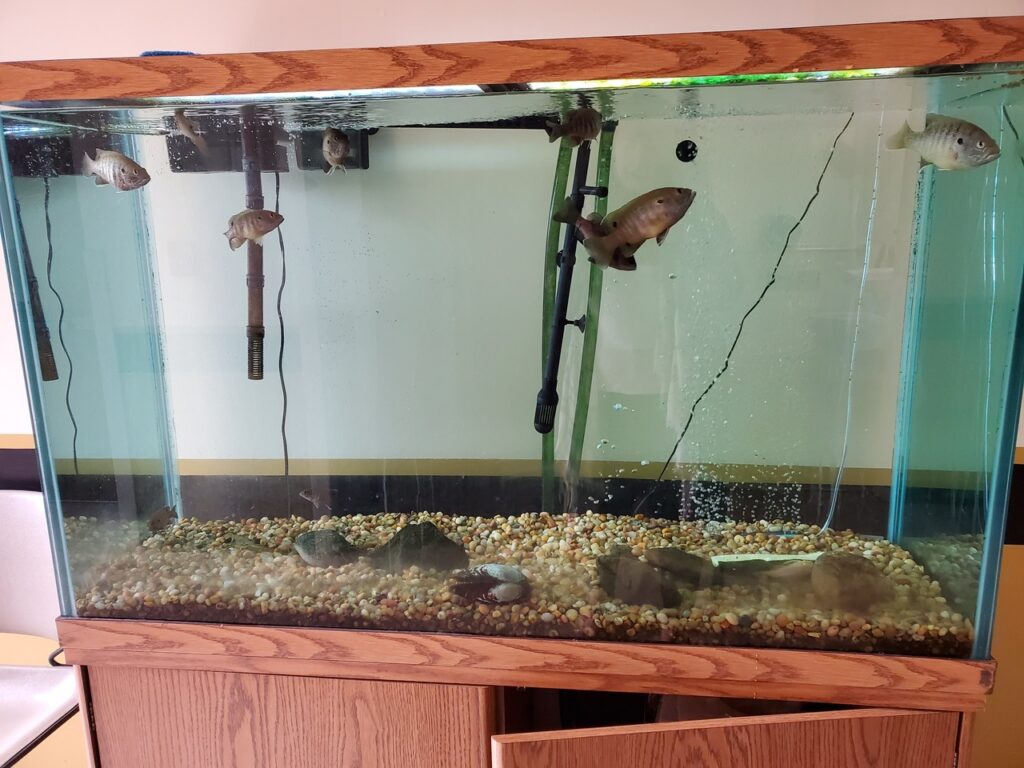Dr. Micheal Fultz, associate professor of chemistry at State, tends to the wildlife in three tanks in the Chemistry Department. The tanks and their inhabitants are part of the West Virginia EPSCoR program on water quality.

The EPSCoR project is a multi-institution National Science Foundation program designed to help people understand what wildlife is in West Virginia’s waters, Fultz said. The grant supports research efforts like those of Dr. David Huber, who supports both undergraduate and graduate students studying the microbiomes of the Kanawha River.
Fultz said the goals of the program are to:
- sponsor and maintain world-class research;
- develop academic resources, a skilled workforce and a competitive research infrastructure;
- encourage the transfer of technology to support economic growth, jobs and life enhancement;
- encourage participation of K-12, women, rural underserved and minorities in science, technology, engineering and mathematics; and
- maintain a focus within state government to attain these goals statewide.
For more information on EPSCoR please visit the website https://westvirginiaresearch.org/programs/epscor.
The fish tanks are part of the outreach component of the grant, which is designed to educate the general public on West Virginia’s waterways and allow people to know what is living in the river, said Fultz, who is responsible for feeding the creatures and cleaning the three tanks.
Fultz said siphons attached to the tank help remove wastewater through a tube connected to a floor drain.
According to Fultz, each of the tanks needs 30 or 40 gallons of the tank water replaced once a month to maintain the water’s chemistry. That helps keep algae under control. The only non-native fish in the tank are the Plecostomus, which clean the tank.
Fultz said one type of Plecostomus, the bushy nose Pleco, has appendages on the nose that look like hair, which helps it find food.
The aquarium holds different types of wood, pebbles and rocks. Some fish hide under the large rocks to camouflage themselves. Those types of fish enjoy darkness and quiet.

Fultz said the fish in the three tanks are fed a balanced diet of shrimp, mealworms and minnows. Fultz recently placed a zucchini in the aquarium to diversify the Plecos’ diet.
The diet is strictly controlled so the fish are not overfed. In addition, limiting the diet reduces the amount of food that decomposes and distorts the chemistry of the water.
Each of the tanks has excess filtration – about 50% more than required – to help maintain clean water for the fish.
Fultz checks the pH of the water on a regular basis to monitor the acid concentration in the tanks. If the pH is too high or low, it will kill the fish.
Fultz tests the water’s pH by taking a sample in a test tube and adding two drops of pH test solution. He then compares the colors of the water with those in the pH booklet. He also monitors ammonia and nitrates that come from fish waste. The pH of West Virginia’s waters is generally between 6 and 8. Fultz added baking soda to neutralize some of the acid, increasing the pH in the tanks to closer to 7.
He maintains a healthy bacteria count, which converts the toxic ammonia into safer nitrate that plants.
Fun Fact
The fish and other animals, about 35 altogether, are separated among three tanks based on their size to prevent predatory behavior of the larger fish. Fish in the tanks include bluegill, channel catfish, green sunfish, pumpkin seeds (first floor), and channel catfish, spotted bass, bushy nose Pleco, crayfish and common Pleco (second floor).


